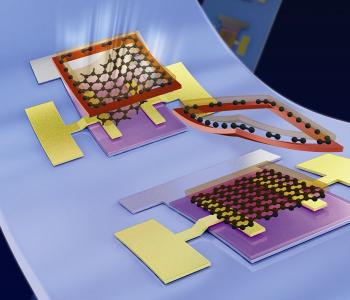Researchers from Korea's Pohang University of Science and Technology developed a new dry process to transfer CVD-grown graphene. Avoiding any wet chemistry step means that you can place the graphene on water sensitive substrates. The researchers explain that this method may create better performing graphene as they contain fewer defects and charged impurities.

The process starts by coating the graphene with polymeric bilayers made of polybutadiene (PBU) and PMMA. The catalytic metal beneath the graphene are removed and the polymers and graphene are together placed on a sample holder. This is moved onto the target substrate and then nitrogen gas is used to break the edges of the graphene/polymer structure, which is then laminated onto the target substrate.
The researchers explain that the polymeric bi-layers provide robust support during the transfer process and they also effectively passivate the graphene, which protects the carbon sheet from undesirable charged impurities.
To demonstrate this technique, the researchers transferred CVD-grown graphene onto a water-sensitive substrate and have even made flexible, air-stable, low-voltage FETs from the transferred materials. They say that the GFETs produced using this technology have outstanding carrier mobility and an average Dirac point (which indicates how ‘clean’ a device is) of around 0.38 V. This appears to be better than any G-FETs transferred using wet chemistry processes.
Those G-FETs are also flexible and remain high-performance even after they have been bent and released more than 5000 times or exposed to 80% relative humidity. The team says that it is now busy making flexible graphene circuits that contain graphene transferred using its dry technique.